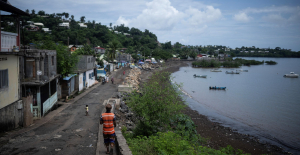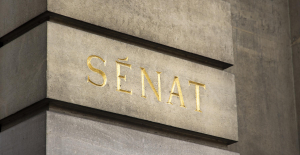"The United Nations has begun an operation to defuse what could be the biggest time bomb in the world": the words chosen this Tuesday by the Secretary General of the United Nations, Antonio Guterres, are strong. But they are assumed: the work started on July 25 in the Red Sea is "unique", both in its magnitude and in its complexity, hammered Achim Steiner, administrator of the United Nations Development Program (UNDP).
Expected for years, this mission aims to remove more than a million barrels of oil from a decomposing ship off the coast of Yemen. This tanker, flying the Yemeni flag, called FSO Safer, threatens at any time to sink or explode, which would spill four times more oil than the Exxon Valdez disaster in 1989, off the coast of Alaska. The poorest country on the Arabian Peninsula, Yemen is torn apart by an armed conflict between the Houthis, Iranian-backed insurgents, and pro-government forces backed by Saudi Arabia. This war led to the suspension of maintenance operations on the 47-year-old Safer since 2015. This vessel was used as a floating oil storage platform and the systems to pump gas into its tanks stopped working in 2017, which increased the risk of explosion.
The task promises to be complex to say the least: the FSO Safer is in a disastrous state, corroded by rust and fungi which are spreading on its hull, the thickness of which has reduced by four millimeters in some places, according to AFP journalists. On July 19, a perilous repair was carried out by the reduced crew - less than 10 people against 72 before the war - after the detection of an anomaly in the engine room. Braving the heat and fumes from crude oil, sailors managed to repair a burst pipe using makeshift iron bands before divers installed a steel plate to prevent seawater from drowning the vessel.
UN officials have long warned about this issue, believing that the Red Sea and the Yemeni coastline are in serious danger. An oil spill would devastate fishing communities on the Yemeni coast, depriving 200,000 people of their livelihoods. The disaster could also lead to the closure of ports, vital for the delivery of food, fuel and other essential supplies to Yemen where most of the population depends on international humanitarian aid to survive. The oil slick could also reach Saudi Arabia, Eritrea, Djibouti and Somalia and produce highly polluted air over a wide area. Another potential consequence: maritime traffic between the Bab al-Mandab Strait and the Suez Canal, route to the Mediterranean, could be disrupted at a cost of billions of dollars per day, according to the UN.
Attempts to inspect the boat stalled for years as UN requests for access were repeatedly denied by rebels who control much of northern and western Yemen, including the port of Hodeido. The Houthis are accused of using the ship as a bargaining chip and have long demanded oil revenues be paid to pay the salaries of their officials. After long negotiations, the inspections finally began on May 30 with the arrival of a team of experts from the private company SMIT Salvage. On Monday, July 17, the UN handed over to Yemen a ship in which the stored oil must be transferred, the "Yemen" (formerly Nautica), bought by the organization, which is quite rare.
“Setting up such a rescue operation is a physical and security challenge, underlines Achim Steiner, with Le Figaro. It was also a challenge to raise the funds needed to find a vessel in a global market that had almost no very large crude carriers available for sale.” Fourteen insurance companies took part in this very perilous rescue project. To finance it, the United Nations has crowdfunded and says it still needs an additional $22 million. The UNDP hopes for the mobilization of the oil, gas and maritime transport industry because “it is about their operating environment”, indicates the UN.
Even if the transfer of crude is successful, the Safer will still pose an "environmental threat", as it contains "viscous hydrocarbon residues and is at risk of breaking", nevertheless warned the organization. "With the local authorities we are training for an emergency plan in the event of an incident", underlined Achim Steiner last week, in the event that this would occur during the pumping operations. Once the pumping is complete, the question of ownership of this black gold will arise, as the rivalry between Houthi rebels and government forces continues to rage, even as fighting has largely subsided on the ground. The transfer of the 150,000 tonnes of oil on board the tanker to a replacement vessel should cost a total of 143 million dollars and take 19 days.

 Gaza: under the spotlight, the Israeli-Palestinian conflict shakes up the Eurovision contest
Gaza: under the spotlight, the Israeli-Palestinian conflict shakes up the Eurovision contest Black soldier killed by a police officer in the United States: the sheriff publishes the video of the arrest
Black soldier killed by a police officer in the United States: the sheriff publishes the video of the arrest In Malmö, the Eurovision party transformed into entrenched camps
In Malmö, the Eurovision party transformed into entrenched camps In Russia, Vladimir Putin stigmatizes “Western elites”
In Russia, Vladimir Putin stigmatizes “Western elites” “Mediterranean diet” or “DASH”, two good tips for eating better
“Mediterranean diet” or “DASH”, two good tips for eating better Fatal case of cholera in Mayotte: the epidemic is “contained”, assures the government
Fatal case of cholera in Mayotte: the epidemic is “contained”, assures the government The presence of blood in the urine, a warning sign of bladder cancer
The presence of blood in the urine, a warning sign of bladder cancer A baby whose mother smoked during pregnancy will age more quickly
A baby whose mother smoked during pregnancy will age more quickly Artificial intelligence lies, cheats and deceives us, and that's a problem, experts warn
Artificial intelligence lies, cheats and deceives us, and that's a problem, experts warn Google Cloud mistakenly deletes UniSuper fund account and deprives 600,000 Australians of their superannuation
Google Cloud mistakenly deletes UniSuper fund account and deprives 600,000 Australians of their superannuation IBM, Amazon, Hager... These record investments expected at the Choose France summit
IBM, Amazon, Hager... These record investments expected at the Choose France summit Boeing's black streak: a second Air France flight diverted in three days for “a smell of heat”
Boeing's black streak: a second Air France flight diverted in three days for “a smell of heat” Eurovision 2024: Bernard-Henri Lévy will vote for the “courageous” Eden Golan in the face of “the wind of hatred against the Jews”
Eurovision 2024: Bernard-Henri Lévy will vote for the “courageous” Eden Golan in the face of “the wind of hatred against the Jews” Eurovision 2024: Joost Klein, the Dutch candidate, excluded from the competition
Eurovision 2024: Joost Klein, the Dutch candidate, excluded from the competition The origin of the vandalized world, the Musée d’Orsay files a complaint
The origin of the vandalized world, the Musée d’Orsay files a complaint London: two octogenarians charged after damaging the “Magna Carta” window
London: two octogenarians charged after damaging the “Magna Carta” window Omoda 7, another Chinese car that could be manufactured in Spain
Omoda 7, another Chinese car that could be manufactured in Spain BYD chooses CA Auto Bank as financial partner in Spain
BYD chooses CA Auto Bank as financial partner in Spain Tesla and Baidu sign key agreement to boost development of autonomous driving
Tesla and Baidu sign key agreement to boost development of autonomous driving Skoda Kodiaq 2024: a 'beast' plug-in hybrid SUV
Skoda Kodiaq 2024: a 'beast' plug-in hybrid SUV The home mortgage firm rises 3.8% in February and the average interest moderates to 3.33%
The home mortgage firm rises 3.8% in February and the average interest moderates to 3.33% This is how housing prices have changed in Spain in the last decade
This is how housing prices have changed in Spain in the last decade The home mortgage firm drops 10% in January and interest soars to 3.46%
The home mortgage firm drops 10% in January and interest soars to 3.46% The jewel of the Rocío de Nagüeles urbanization: a dream villa in Marbella
The jewel of the Rocío de Nagüeles urbanization: a dream villa in Marbella Diving into the secrets of the National Assembly
Diving into the secrets of the National Assembly Institutions: senators want to restore the accumulation of mandates and put an end to the automatic presence of ex-presidents on the Constitutional Council
Institutions: senators want to restore the accumulation of mandates and put an end to the automatic presence of ex-presidents on the Constitutional Council Europeans: David Lisnard expresses his “essential and vital” support for François-Xavier Bellamy
Europeans: David Lisnard expresses his “essential and vital” support for François-Xavier Bellamy Facing Jordan Bardella, the popularity match turns to Gabriel Attal’s advantage
Facing Jordan Bardella, the popularity match turns to Gabriel Attal’s advantage These French cities that will boycott the World Cup in Qatar
These French cities that will boycott the World Cup in Qatar Top 14: in video, the incredible 100 meter test scored by Aviron Bayonnais against Racing
Top 14: in video, the incredible 100 meter test scored by Aviron Bayonnais against Racing Top 14: A Graou-Mallia hinge, Capuozzo back... the composition of Stade Toulousain for the classico.
Top 14: A Graou-Mallia hinge, Capuozzo back... the composition of Stade Toulousain for the classico. MotoGP: It won't be easy for Bagnaia to win a third title, says legend Valentino Rossi
MotoGP: It won't be easy for Bagnaia to win a third title, says legend Valentino Rossi Handball: the Blues win easily against the United States
Handball: the Blues win easily against the United States


















